AMD Radeon HD 7970 Review: 28nm And Graphics Core Next, Together As One
by Ryan Smith on December 22, 2011 12:00 AM EST- Posted in
- GPUs
- AMD
- Radeon
- ATI
- Radeon HD 7000
Crysis: Warhead
Kicking things off as always is Crysis: Warhead. It’s no longer the toughest game in our benchmark suite, but it’s still a technically complex game that has proven to be a very consistent benchmark. Thus even 4 years since the release of the original Crysis, “but can it run Crysis?” is still an important question, and the answer continues to be “no.” While we’re closer than ever, full Enthusiast settings at a 60fps is still beyond the grasp of a single-GPU card.
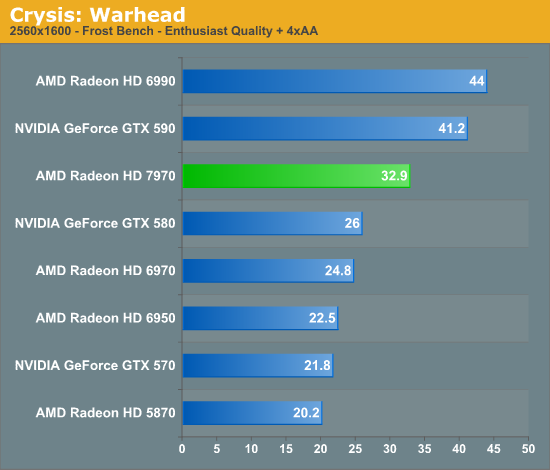

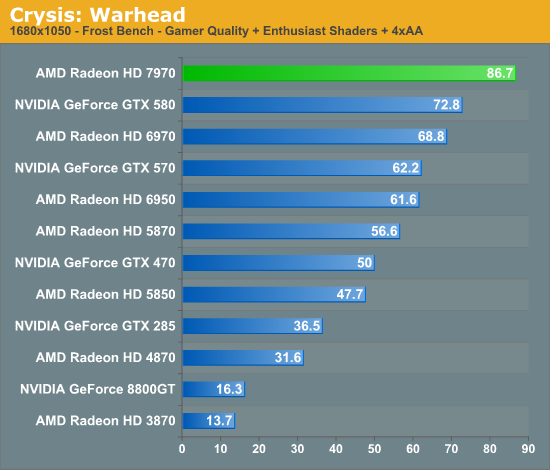
This year we’ve finally cranked our settings up to full Enthusiast quality for 2560 and 1920, so we can finally see where the bar lies. To that extent the 7970 is closer than any single-GPU card before as we’d imagine, but it’s going to take one more jump (~20%) to finally break 60fps at 1920.
Looking at the 7970 relative to other cards, there are a few specific points to look at; the GTX 580 is of course its closest competitor, but we can also see how it does compared to AMD’s previous leader, the 6970, and how far we’ve come compared to DX10 generation cards.
One thing that’s clear from the start is that the tendency for leads to scale with the resolution tested still stands. At 2560 the 7970 enjoys a 26% lead over the GTX 580, but at 1920 that’s only a 20% lead and it shrinks just a bit more to 19% at 1680. Even compared to the 6970 that trend holds, as a 32% lead is reduced to 28% and then 26%. If the 7970 needs high resolutions to really stretch its legs that will be good news for Eyefinity users, but given that most gamers are still on a single monitor it may leave AMD closer to 40nm products in performance than they’d like.
Speaking of 40nm products, both of our dual-GPU entries, the Radeon HD 6990 and GeForce GTX 590 are enjoying lofty leads over the 7970 even with the advantage of its smaller fabrication process. To catch up to those dual-GPU cards from the 6970 would require a 70%+ increase in performance, and even with a full node difference it’s clear that this is not going to happen. Not that it’s completely out of reach for the 7970 once you start looking at overclocking, but the reduction in power usage when moving from TSMC 40nm to 28nm isn’t nearly large enough to make that happen while maintaining the 6970’s power envelope. Dual-GPU owners will continue to enjoy a comfortable lead over even the 7970 for the time being, but with the 7970 being built on a 28nm process the power/temp tradeoff for those cards is even greater compared to 40nm products.
Meanwhile it’s interesting to note just how much progress we’ve made since the DX10 generation though; at 1920 the 7970 is 130% faster than the GTX 285 and 170% faster than the Radeon HD 4870. Existing users who skip a generation are a huge market for AMD and NVIDIA, and with this kind of performance they’re in a good position to finally convince those users to make the jump to DX11.
Finally it should be noted that Crysis is often a good benchmark for predicting overall performance trends, and as you will see it hasn’t let us down here. How well the 7970 performs relative to its competition will depend on the specific game, but 20-25% isn’t too far off from reality.
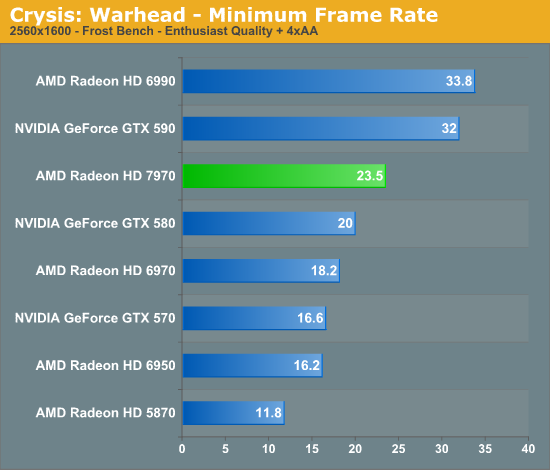
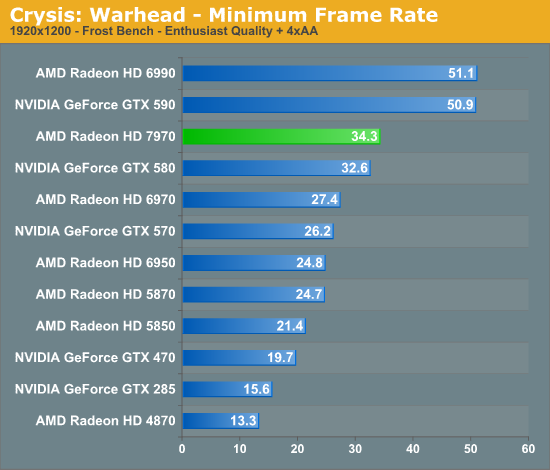
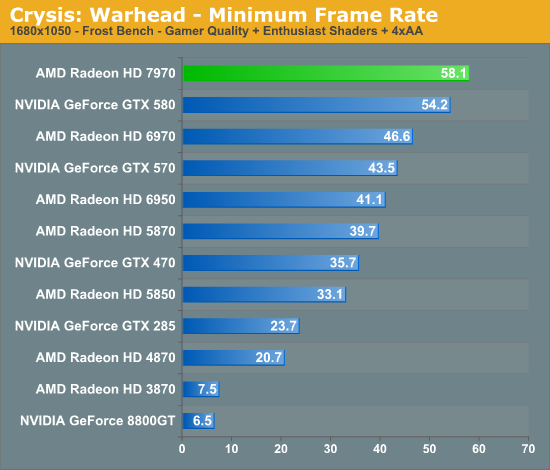
Looking at our minimum framerates it’s a bit surprising to see that while the 7970 has a clear lead when it comes to average framerates the minimums are only significantly better at 2560. At that resolution the lowest framerate for the 7970 is 23.5 versus 20 for the GTX 580, but at 1920 that becomes a 2fps, 5% difference. It’s not that the 7970 was any less smooth in playing Crysis, but in those few critical moments it looks to be dipping a bit more than the GTX 580.
Compared to the 6970 on the other hand the minimum framerate difference is much larger and much more consistent. At 2560 the 7970’s minimums are 29% better, and even at lower resolutions it holds at around 25%. Clearly even with AMD’s new architecture their designs still inherit some of the traits of their old designs.










292 Comments
View All Comments
chiddy - Thursday, December 22, 2011 - link
Ryan,Thanks for the great review. My only gripe - and I've been noticing this for a while - is the complete non-mention of drivers or driver releases for Linux/Unix and/or their problems.
For example, Catalyst drivers exhibit graphical corruption when using the latest version (Version 3) of Gnome Desktop Environment since its release before April. This is a major bug which required most users of AMD/ATI GPUs to either switch desktop environments, switch to Nvidia or Intel GPUs, or use the open source drivers which lack many features. A partial fix appeared in Catalyst 11.9 making Gnome3 usable but there are still elements of screen corruption on occassion. (Details in the "non-official" AMD run bugzilla http://ati.cchtml.com/show_bug.cgi?id=99 ).
AMD have numerous other issues with Linux Catalyst drivers including buggy openGL implementation, etc.
Essentially, as a hardware review, a quick once over with non-Microsoft OSs would help alot, especially for products which are marketed as supporting such platforms.
Regards,
kyuu - Thursday, December 22, 2011 - link
Why in the heck would they mention Linux drivers and their issues in an article covering the (paper) release and preliminary benchmarking of AMD's new graphics cards? It has nada to do with the subject at hand.Besides, hardly anyone cares, and those that do care already know.
chiddy - Thursday, December 22, 2011 - link
And I guess that AMD GPUs are sold as "Windows Only"?Thanks for your informative insight.
MrSpadge - Thursday, December 22, 2011 - link
There are no games for *nix and everything always depends on your distribution. The problems are so diverse and numerous.. it would take an entire article to briefly touch this field.Exagerating, but I really wouldn't be interested in endless *nix troubleshooting. Hell, I can't even get nVidia 2D acceleration in CentOS..
chiddy - Thursday, December 22, 2011 - link
You have a valid point on that front and I agree, nor would I expect such an article any time soon.However, on the other hand, one would at the very least expect a GPU using manufacturer released drivers to load a usable desktop. This is an issue that was distro agnostic and instantly noticeable, and only affected AMD hardware, as do most *nix GPU driver issues!
If all that was done during a new GPU review was fire it up in any *nix distribution of choice for just a few minutes (even Ubuntu as I think its the most popular at the moment) to ensure that the basics work it would still be a great help.
I will have to accept though that there is precious little interest!
Ryan Smith - Thursday, December 22, 2011 - link
Hi Chiddy;It's a fair request, so I'll give you a fair answer.
The fact of the matter is that Linux drivers are not a top priority for either NVIDIA or AMD. Neither party makes Linux drivers available for our launch reviews, so I wouldn't be able to test new cards at launch. Not to speak for either company, but how many users are shelling out $550 to run Linux? Cards like the 7970 have a very specifically defined role: Windows gaming video card, and their actions reflect this.
At best we'd be able to look at these issues at some point after the launch when AMD or NVIDIA have added support for the new product to their respective Linux drivers. But that far after the product's launch and for such a small category of users (there just aren't many desktop Linux users these days), I'm not sure it would be worth the effort on our part.
chiddy - Friday, December 23, 2011 - link
Hi Ryan,Thanks very much for taking the time to respond. I fully appreciate your position, particularly as the posts above very much corroborate the lack of interest!
Thanks again for the response, I very much appreciate the hard work yourself and the rest of the AT team are doing, and its quality speaks for itself in the steady increase in readers over the years.
If you do however ever find the time to do a brief piece on *nix GPU support after launch of the next generation nVidia and AMD GPUs that would be wonderful - and even though one would definately not buy a top level GPU for *nix, it would very much help those of us who are dual booting (in my case Windows for gaming / Scientific Linux for work), and somewhat remove the guessing game during purchase time. If not though I fully understand :-).
Regards,
Ali
CeriseCogburn - Thursday, March 8, 2012 - link
Nvidia consistenly wins over and over again in this area, so it's "of no interest", like PhysX...AmdInside - Thursday, December 22, 2011 - link
I won't be getting much sleep tonight since that article took a long time to read (can't imagine how long it must have taken to write up). Great article as usual. While it has some very nice features, all in all, it doesn't make me regret my purchase of a Geforce GTX 580 a couple of months ago. Especially since I mainly picked it up for Battlefield 3.ET - Thursday, December 22, 2011 - link
The Cayman GPU's got quite a performance boost from drivers over time, gaining on NVIDIA's GPU since their launce. The difference in architecture between the 79x0 and 69x0 is higher than the 69x0 and 58x0, so I'm sure there's quite a bit of room for performance improvement in games.Have to say though that I really hope AMD stops increasing the card size each generation.